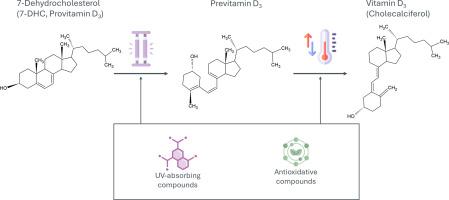An interplay of light and temperature: Vitamin D3 formation in vitro, a model for in vivo plant studies
IF 3.261
引用次数: 0
Abstract
Vitamin D deficiency is a global issue that requires attention, given its essential functions in the human body. The synthesis of vitamin D3 in the human skin is subject to limitations related to the availability of UV radiation, which can be particularly limited at higher latitudes, especially during the winter months. Additionally, vitamin D3 can be acquired through diet. Given that most vitamin D sources are animal-based, the discovery of vitamin D3 in plants is of particular interest to those following vegan or vegetarian diets. While the characteristics of vitamin D biosynthesis in the human skin are well established, there is a lack of knowledge regarding biosynthesis in plants. This study aimed to evaluate the influence of several factors, including light, temperature, and plant matrix compounds, on the vitamin D3 conversion reaction. The formation of previtamin D3 from 7-dehydrocholesterol (7-DHC) was demonstrated to be dependent on UVC and UVB light, while the subsequent formation of vitamin D3 from previtamin D3 was shown to be dependent on temperature. Exposure to longer UV wavelengths led to a relative increase in lumisterol content. Furthermore, a concentration-dependent effect of UV-absorbing compounds was observed. These novel insights into the formation of vitamin D3 will underpin future strategies aimed at optimising vitamin D3 content in crop species.

光和温度的相互作用维生素 D3 在体外形成,植物体内研究的模型
鉴于维生素 D 在人体中的重要功能,维生素 D 缺乏症是一个需要关注的全球性问题。人体皮肤中维生素 D3 的合成受到紫外线辐射的限制,在高纬度地区,尤其是在冬季,紫外线辐射尤其有限。此外,维生素 D3 还可以通过饮食获得。鉴于大多数维生素 D 的来源都是动物性的,因此植物中维生素 D3 的发现对于那些素食主义者来说尤其重要。虽然维生素 D 在人体皮肤中的生物合成特点已得到公认,但人们对植物中的生物合成还缺乏了解。本研究旨在评估光照、温度和植物基质化合物等因素对维生素 D3 转化反应的影响。研究证明,前维生素 D3 由 7-脱氢胆固醇(7-DHC)形成取决于紫外线和 UVB 光,而随后由前维生素 D3 形成维生素 D3 则取决于温度。暴露在较长的紫外线波长下,紫杉醇的含量会相对增加。此外,还观察到紫外线吸收化合物的浓度效应。这些关于维生素 D3 形成的新见解将为未来旨在优化作物中维生素 D3 含量的战略提供依据。
本文章由计算机程序翻译,如有差异,请以英文原文为准。
求助全文
约1分钟内获得全文
求助全文

 求助内容:
求助内容: 应助结果提醒方式:
应助结果提醒方式:


